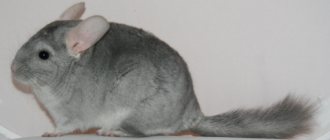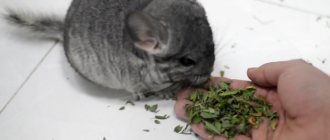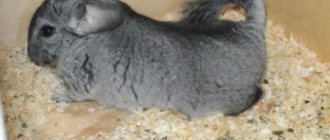Information / How to place a female chinchilla with a male chinchilla
WE WARN YOU IMMEDIATELY: you CANNOT just immediately put a girl chinchilla in a cage with a boy chinchilla!
Domestic chinchillas retain the instincts inherited from their long-standing wild ancestors. In the wild, chinchillas live in herds, and matriarchy reigns within the group. The main chinchilla female (alpha female) herself chooses a male for mating and controls the mating of the remaining females of the lower level of the hierarchy. This reproduction mechanism is due to the poor food supply in the Andes Mountains; it does not allow the chinchilla population to grow excessively.
A female chinchilla will not tolerate an unexpected invasion of the personal space of an unfamiliar male; she will drive him away, bite him, and even kill him.
The procedure for mounting chinchillas takes time and requires attention and control. Let us remind you that sexually mature chinchillas are suitable for creating a pair - a male and a female, at least 10 months old, and preferably a year. Below we offer our own method of planting.
According to our nursery’s method, chinchillas are planted in stages:
| Stage 1. Correspondence acquaintance | Male and female chinchillas get to know each other's scents |
| Stage 2. Rally | The male and female meet and slightly get used to each other |
| Stage 3. Final addiction | A male and a female sit in the same cage and get along completely |
Here's what's done at each stage:
How to board chinchillas
In their natural habitat, these rodents live in large groups, but at home, chinchillas can live alone, feeling quite comfortable. And a pet, accustomed to being the only full owner of his home, may negatively perceive a new neighbor moving in with him. To prevent the animals from experiencing panic and stress during boarding, several rules should be followed during such an important process, taking into account not only the age, but also the gender of the animals.
General rules for boarding rodents:
Before introducing a new resident into the cage, it is necessary to observe a thirty-day quarantine to ensure that the acquired pet is completely healthy:
- The first meeting of furry rodents is best done during the daytime, when they are sleepy and calm;
- there must be shelter in the cage so that the animal can hide in the event of an attack by an aggressive neighbor;
- when sitting down the animals, you can invite them to take a joint sand bath, this will bring them closer and relax;
- regarding how many chinchillas can be kept in one cage, it is advisable to house no more than three or four rodents together, and then only on condition that the cage is spacious enough;
- if a chinchilla is used to living alone for several years, then the animal may refuse to accept a new neighbor and in this case, it is better to leave everything as it is.
The first meeting should be done during the day
Important: under no circumstances should pets be left unattended during this process, because in the event of a fierce fight between rodents, immediate intervention by the owner will be required.
About the funny features of chinchillas
Chinchillas are also afraid of very loud and sharp sounds. When they hear something like this, they often experience great stress. Please behave calmly around the cage, speak in a quiet and even tone. A chinchilla under stress is prone to losing its magnificent fur - it falls out in whole sections. Let us repeat: if you risk taking your pets out of the cage and try to accustom them to being handled, do it very carefully and preferably not high from the floor level. Chinchillas are afraid of falls even from a small height.
Placing same-sex chinchillas together
Chinchillas, living without a pair, are easier to tame and more attached to the owner. But, if the owner does not have the opportunity to devote a lot of time to the pet, the best way out is to place a friend with him.
When purchasing a same-sex friend for a furry pet, the owner should know that only boys can get along together. Perhaps, at first, two males will start quarrels and fights with each other, but as they get used to it, they will become, if not friends, then good neighbors.
Two adult female chinchillas will not get along with each other, so you should not even try to put them in the same cage. Only chinchilla sisters from the same family, or girls raised together from a young age, can share a home with each other.
Video: what age difference is acceptable when boarding chinchillas
Same-sex couples are better pets than singles
If you do not want to have offspring from chinchillas, care for a pregnant female and newborn chinchillas, you can consider the option of creating a same-sex pair. Female sisters or male brothers are ideal for this. They, being relatives, have been together since childhood. A pair can be formed from unrelated females or males if they are mated in childhood. Kids quickly get used to each other and will not conflict when they grow up. In our nursery, chinchillas that have reached the age of 2 months are separated from their mothers into common same-sex groups.
To keep as a pet, we recommend purchasing a pair of same-sex chinchillas. A single pet will experience stress from loneliness, but two chinchillas will play with each other and never get bored.
How to breed chinchillas of different sexes
Knowing the behavioral characteristics of females and males, you can avoid a conflict situation when placing furry pets of different sexes:
- if placement is carried out with the aim of producing offspring, then it is advisable to place the female in the cage with the male, since females more zealously defend their territory;
- a chinchilla pair is selected no earlier than the animal reaches six months of age;
- before placing a boy and a girl in the same cage, their homes are placed close together so that they can get to know each other and get used to the smell of others;
- if the acquaintance was successful and the rodents do not show aggression towards each other, they are swapped: the male is released into the female’s cage for several hours and vice versa;
- you cannot place a male with a girl when she is in heat, since boys are impatient at this moment, and the female needs time to get used to the suitor;
- To form a trio of adult chinchillas, follows this rule: one female, two males, since two girls will not tolerate each other in the same cage.
Important: if the female categorically does not want to mate with the male and continues to behave aggressively, it is better to find her a new partner.
Re: Age of mating of a female with a male
If the weight of the male is approximately the same as that of your female, then you can breed, if the groom is larger, then let the girl grow a little more. And so it is difficult to give definite answers - each breeder decides for himself - a lot still depends on the character and temperament of the animals - there is “ lazy" and "preoccupied", there are good and evil. If the female is aggressive, then I plant her as soon as she reaches a weight of 500 grams - the younger she is, the better she sits; if she is kind, then I keep her with my friends longer.
Diamond Angora girls' best friends Information hidden
I will buy chinchillas with a beige gene in the phenotype.
Chinchilla and guinea pig in one cage
It is theoretically possible to house a chinchilla and a guinea pig together, because they are similar in size and feeding method. In addition, both of these rodents are friendly and peaceful and can become true friends.
But keeping them in the same cage unless absolutely necessary is still not recommended. The fact is that the cages of furry pets are equipped with shelves at different heights, and guinea pigs do not know how to jump. And if a pig climbs onto a shelf, falling from it may break its leg or damage its internal organs, which can lead to the death of the animal.
Therefore, let pets who have become friends communicate and play during joint walks, but each should have a separate home.
Exercises and training for chinchillas
Chinchillas are nocturnal, so they sleep most of the day. They are most active in the early evening, so now is a good time to take them out for a run. Make sure they are supervised because they love to explore everything with their teeth, including electrical wires.
Before you let your chinchillas run around your house, make sure you can catch them again. Chinchillas can be tamed with a little time and training. When the chinchilla comes forward, gently pet it under the chin. Don't try to catch them the first time, just give them a treat and let them go so they don't associate you with being caught. Raisins are one of their favorite treats, so offer them by hand. Be careful because a scared chinchilla will stand on its hind legs and spray urine at any potential threat!
Once your chinchilla is confident in taking treats and allows you to pet him, you can release him outside. Start with a small space and then try offering a treat to encourage your pet to come to your arm. Don't try to catch the chinchilla just yet, but give him a treat and release him again several times.
To pick up your chinchilla, support their entire body with your hand and gently hold them by grasping the base of the tail. Never pick up a chinchilla by the tail as this can hurt it or cause serious injury. A frightened chinchilla that is handled too tightly will shed chunks of fur, so if this happens you will be being too rough.
Chinchilla and rabbit in the same cage
Rodent lovers sometimes keep a decorative rabbit and a chinchilla in the same house. When letting their little pets out for a walk around the apartment, many owners notice that the animals show interest in each other and even play together. Watching the touching friendship of furry animals, the owners decide that a rabbit and a chinchilla will also get along well in the same cage, but this is a big misconception.
There are several reasons why these animals cannot be kept in the same home:
- The chinchilla considers its own cage to be its sole possession and will not tolerate the presence of other animals on its territory;
- rabbits need a long, low cage, while the home of fluffy animals that love to jump should be high, with numerous shelves at different levels;
- Being nocturnal animals, chinchillas sleep during the day and frolic at night. The peak activity of rabbits occurs at dusk, that is, in the morning and evening hours, so at night the chinchilla will prevent the rabbit from sleeping, and he, in turn, will not allow his neighbor to rest during the day.
Chinchilla and rabbit can play together
Important: despite their apparent fragility, rabbits are quite strong animals. If a fight breaks out between furry pets over food or territory, the rabbit can cause serious injury to the chinchilla. Therefore, they can not only be kept in the same cage, but also keep an eye on your pets during walks together.
Does your chinchilla need a friend?
Enclosures with chinchillas always attract crowds of admiring onlookers in pet stores. The women whisper in a low voice: “Are these the same ones?” That’s right: in front of you are “those” animals with an amazingly beautiful silver coat. Through the efforts of furriers, chinchilla fur coats are turned into much more serious and expensive fur coats for beautiful ladies. Let's put an end to this sad place. Let’s just say that we fully share all the aspirations and fears of animal rights activists and other people who are not indifferent to the problem.
Chinchillas are the most expensive rodent pets offered for sale. We can all probably guess the reasons. Animals have taken root well in our homes and give their owners many pleasant moments. The lifespan of animals in captivity is up to 20 years. And simple aesthetic pleasure is a great thing.
Chinchillas, for all their visual attractiveness, do not really like to be picked up and stroked. Moreover, they actively object to all encroachments on their personal space; they may scratch or bite. Therefore, loving owners can only admire the tricks of their pets.
Chinchilla and hamster in the same cage
A chinchilla and a hamster will also not get along together in the same cage, because these animals differ not only in size, character and behavior. Furry pets have completely different body needs and feeding them with one food is not recommended.
Food for chinchillas contains mainly cereals, dried greens and seeds, and ready-made food for hamsters contains dried fruits and vegetables, which do not provide any benefit to animals from South America. Fresh vegetables and fruits, which are delicacies for hamsters, should also not be consumed by chinchillas.
The menu of hamsters can sometimes be diversified with dairy products, but giving chinchillas milk or cottage cheese is contraindicated, as this will lead to the development of gastrointestinal tract diseases or even food poisoning in pets.
Chinchilla treats
Raisins and sultans are ideal treats for chinchillas and can also be used as training rewards. Don't feed your chinchilla too much so that they still perceive raisins as a treat.
Some chinchillas also like a small piece of fresh vegetables, such as carrots, but try not to give them too much because it can cause diarrhea. Peanuts and sunflower seeds should be avoided as they are too fatty.
Don't give them too many treats as this can upset their stomach.
Should I buy one chinchilla or two?
Before purchasing a chinchilla, many people ask themselves the question, “How many chinchillas should I buy, one or two?”
The answer depends on who and for what purpose you are buying the animal.
If you are planning to breed these wonderful animals at home, then you definitely need to buy two: a female and a male.
If you need a chinchilla as a pet for you, your child or for your parents, then it is better for you to buy one chinchilla, or two of the same sex: there will be no offspring, but it will be more fun for them to live in company.
However, chinchillas can live well alone if their owner has enough time to communicate with the pet. This way they will be more willing to be held and seek contact and communication with a person. Chinchillas do not need, like other animals, to “give birth once for health.” The absence of offspring will not affect their health in any way.
Chinchillas are like people, different. Some people love and appreciate loneliness, but most are truly happy only when they have a family or a friend. If you put two males or two females in one cage while they are still babies, they will easily get used to each other, will be friends all their lives and there will be no problems. You can buy two sisters or two brothers at once. But still, it seems to me that it is more interesting to observe the complex relationships of a full-fledged chinchilla family.
Selecting a pair and placing a female and a male together is not an easy task. If the animals don’t like each other, or the cage is too small for two, there will be a fight, long battles for territory, torn pieces of fur, bitten noses, etc. It is unlikely that you want your children to watch this and get upset. In addition, it is necessary to have two separate cages for chinchillas (the second, temporary, can be small in size). When puppies are born, the male can cover the female a second time just a few hours after birth, which is also not desirable: the female needs to feed the baby (or babies) with milk, she needs to get stronger and get better after their birth.
Therefore, immediately after the birth of the baby (or babies), it is advisable to place the male in a separate cage, at least for three to four days, and then return him back.
Males are always very caring fathers. They tenderly care for the female and their offspring.
If you still decide to breed chinchillas, then buy a family. And it will be better if the female is at least a month older than the male, since it is not beneficial for females to become pregnant too early. In any case, the breeder of the nursery will always advise you, help you, advise you at any time, or simply place the chinchillas you like together in advance, even before purchasing, and you will not have to solve this problem yourself.
When creating a pair to produce healthy offspring, it is necessary to take into account the origin of the parents and the carriage of genes in chinchillas. All information is contained in the pedigree of the animal. It is unlikely that you will be given a pedigree in a store or market, so it is better to buy an animal from a breeder.
In no case should you engage in inbreeding (pairing full and half siblings, as well as children and parents). From such couples, puppies are either simply not born, or are born deformed with poor health. When I see for sale in a store a bald, rat-like chinchilla with a narrow muzzle and a long body (brrrr!), I understand that there was most likely inbreeding.
You also can’t breed chinchillas if both animals carry a common lethal gene, for example, you can’t put a male and a female together if they are both white (White-Pink, White Velvet, Wilson’s White), and you can’t put two Black Velvets together ( as well as with White Velvet, Beige Velvet, etc.). Such couples will have fewer children, and the offspring may be weak.
In any case, when creating a pair, it is better to consult with the breeder and get from him detailed information about the parents of your animals.
Source
Planting chinchillas - 5 ways
In order to reduce the likelihood of conflict risks when breeding chinchillas of different sexes, you need to know not only the biological characteristics of the body of these animals, but also the nuances of their psychology.
Despite the fact that for humans the chinchilla is an almost odorless animal, nevertheless, one of the main means of communication between chinchillas and each other is smell. Chinchillas recognize each other using primarily their sense of smell.
Therefore, if you try to directly, without preliminary preparation, place one animal with another in a cage in which it has already lived for some time, even if only for a short time, a psychological conflict between them is almost inevitable. The owner of the premises, having discovered a new smell on his “legal” territory, will try to evict its owner.
Naturally, the new settler, in turn, will resist this with all his might and means. Showdowns can take a variety of forms: from light snorting and snorting to serious fights that end in severe injuries.
In order to reduce the initial mutual aggression and protect animals from unnecessary “showdowns,” there are several ways of mutual habituation.
Methods of mutual addiction:
Method 1 is simple . Let’s call it “we are nearby”. In this case, the cage with the new animal is located next to the cage of the old-timer, but in such a way that the chinchillas do not reach each other through the bars and do not bite off each other’s fingers, lips or noses.
Article on the topic: The smallest turtles in the world (photo)
The advantage of this method of habituation is that the animals see each other, smell the neighbor, but at the same time each is in its own territory.
Gradually, the animals get used to one another, and the smells from neighboring cells are no longer felt by them as foreign. Moreover, chinchillas begin to perceive another cage standing nearby as their own habitat, which is still closed to visitors for some reason unknown to them.
That this is really the case is evidenced by the fact that if you leave the cage doors open during a general walk around the apartment, the chinchillas will calmly come in and study their neighbor’s cage. It would seem like a foreign territory... But no! They no longer experience any fear or discomfort.
After the animals get used to each other, they are placed in a common cage. The described method is the simplest, but time-consuming. It can take from several days to several weeks. This method can be recommended to a chinchilla breeder with little experience in keeping these animals.
Method 2. It can be called this way - “they swapped places.” Carriers or small, so-called “exhibition” cages are taken. The chinchillas sit in these carriers for several hours.
Then the chinchillas are changed places - transplanted to where the neighbor used to sit. This chinchilla castling is repeated several times until the chinchillas get used to each other’s smell.
In this case, the carrier is not washed after the previous chinchilla, so as not to remove its smell. After the animals get used to it and stop reacting aggressively to their neighbor, they are released into a common cage.
3 way. It's called "we come to you." Its essence lies in the fact that another chinchilla, which lives in a large cage, is added to it, but... in a carrier. Yes, that’s right, they literally take a carrier with a chinchilla and put it in a large cage.
Article on the topic: The homeland of the red-eared turtle, how and where did the red-eared turtles appear?
Chinchillas will be able to communicate, show dissatisfaction with each other, but they will not be able to seriously fight. As one of the wise correctly noted, “a bad peace is better than a good quarrel.” Is not it? If you try to directly, without prior preparation, place one animal with another in a cage in which it has already lived for some time, even if only for a short time, a psychological conflict between them is almost inevitable.
4 way. It is the reverse version of the previous one. The aboriginal chinchilla is locked in a carrier where the new tenant was previously sitting, and placed in this carrier in his former large cage.
A newcomer who was previously sitting in a carrier is released into the same cage. The neophyte chinchilla moves freely around the cage, leaving its odorous “substances” in different places.
5 way. To make it easier to get used to, you can use a common bathing suit, in which one animal washes first, then the other. In order to choose the most suitable method of boarding for your situation, I recommend paying attention to the character of the chinchillas and their temperament. If both animals are calm, somewhat phlegmatic, and close to each other in age and weight, then you can use the first two methods. They are methods of mild psychological suppression and work well with similar animals.
If one of the chinchillas is noticeably more active and restless than the other, if there is a gap in the weight, age or life experience of the animals, and in the end, if you yourself have no experience of boarding or have, but intuitively feel a possible failure, then it is better to play it safe and To avoid future problems, use the third and fourth methods.
Of course, they are somewhat tougher than the first two, but... in some cases, they are much more effective. And also, I would recommend placing an aggressive animal in a small carrier - this will help somewhat reduce its temperament and reduce the overall intensity of passions. Here, as with people, staying in a small solitary confinement is always more effective than in a large general one. Inexperienced males are especially susceptible to this so-called “stress of the first meeting”. Or experienced ones, but frightened by an extremely aggressive female. It's sad, but it's true...
It is believed that in order for the planting to go smoothly, certain rules should be followed. The boarding of chinchillas should be approached in good faith and carried out with maximum thoughtfulness and care towards the animals. As experience shows, their future life together largely depends on how smoothly the first meeting of chinchillas went.
Article on the topic: Where and how red-eared turtles live in nature
And not only with each other, but also with other chinchillas. A negative experience leaves a serious imprint on the psyche, and it can be quite difficult to get an animal out of a stressful state. According to psychologists, it only takes about 60 seconds for people of different sexes to understand on a subconscious level whether they are suitable for each other for family life.
Chinchillas don't even need this minute. If you suddenly didn’t foresee or foresee something, then the first meeting of the future married couple will end very quickly and negatively - with bickering, a quarrel or even a fight. And this is a real psychological trauma for the chinchilla. Subsequent attempts to reconnect and reconcile animals that quarreled at the first meeting may lead to nothing.
Alas... There is no point in doing anything when the female is in heat. There will be no calm landing. The male will not care about such psychological subtleties as mutual habituation. Male nature will demand its own, what kind of cupids are there! For the female, in turn, the persistent desire of the “first person he meets” to cover her will also not bring the slightest pleasure. The result of all this is an immediate, momentary quarrel.
Now, as for the optimal age to start planting. Based on my own experience, I can say that the first mating in chinchillas should occur no earlier than eight to nine months in females and no earlier than six months in males.
There are, of course, cases of earlier planting, but personally I don’t see anything good in this. What could possibly be good about early pregnancy in a female who is physiologically unprepared for this? Why this unjustified risk?
It's like a lottery, you know. Everything may end well, but... In general, if you, after all, cannot bear to put the health of your children on the line, then so what. Nobody can prohibit this. But you still need to realize that all responsibility for what is happening and possible consequences falls entirely on the owner.
Article on the topic: Turtles from the Red Book of Russia and the World (photo and description)
By the way, early seating can also occur unintentionally - due to ignorance or carelessness. But, as lawyers say, ignorance of the law does not excuse one from responsibility. The physical condition of the chinchillas is also of great importance when boarding.
Naturally, future parents must be healthy, and their body weight must be at least 450-500 grams. everyone has it. This is due to possible weight loss, which can occur during mounting in both females and males, but in any case, it is a bad sign that requires an immediate response from the chinchilla breeder.
In general, when it comes to setting up such a psychologically complex creature as a chinchilla, it is better to play it safe. Believe me, this is exactly the case when moderate conservatism will only be beneficial. For both you and your pet.
Planting chinchillas: opposite-sex and same-sex individuals together in one cage
Information / How to place a female chinchilla with a male chinchilla
WE WARN YOU IMMEDIATELY: you CANNOT just immediately put a girl chinchilla in a cage with a boy chinchilla!
Domestic chinchillas retain the instincts inherited from their long-standing wild ancestors. In the wild, chinchillas live in herds, and matriarchy reigns within the group. The main chinchilla female (alpha female) herself chooses a male for mating and controls the mating of the remaining females of the lower level of the hierarchy. This reproduction mechanism is due to the poor food supply in the Andes Mountains; it does not allow the chinchilla population to grow excessively.
A female chinchilla will not tolerate an unexpected invasion of the personal space of an unfamiliar male; she will drive him away, bite him, and even kill him.
The procedure for mounting chinchillas takes time and requires attention and control. Let us remind you that sexually mature chinchillas are suitable for creating a pair - a male and a female, at least 10 months old, and preferably a year. Below we offer our own method of planting.
According to our nursery’s method, chinchillas are planted in stages:
| Stage 1. Correspondence acquaintance | Male and female chinchillas get to know each other's scents |
| Stage 2. Rally | The male and female meet and slightly get used to each other |
| Stage 3. Final addiction | A male and a female sit in the same cage and get along completely |
Here's what's done at each stage:
Kid or adult
Baby chinchillas become independent at the age of 2 months, and from that moment on they can find new owners. At the age of 7 - 12 months, chinchillas are fully formed as adults. Watching a baby chinchilla and playing with him is very interesting and exciting. A baby chinchilla needs careful care, affection and care, because at an early age there is a risk of hereditary or generic diseases.
In the photo: A 2-month old chinchilla is ready to go to a new family.
An adult chinchilla has the advantage that it is already physically strong, has life experience, its character has developed, and the future owner has a good idea of what quality of pet he is buying. In our nursery we prefer to purchase already grown chinchillas aged 10 months and older. It is at this time that it becomes clear how healthy the chinchilla is and what its potential is in terms of weight, exterior and fur quality.
How to board chinchillas
Chinchillas are school animals that prefer to live in groups, however, the period of domestication was not in vain for them and made adjustments to their habitat. So, now she can live alone and at the same time feel great, receiving the necessary contact and communication from her owner.
Living alone for a long time, a rodent may negatively perceive the appearance of a new chinchilla in its habitat, which now, like the owner’s attention, will have to be divided.
What to do in such a situation and how to make the introduction of animals less painful and dangerous? To get started, you should follow the basic rules and tips below:
- Make sure the animals are healthy.
- It is better to conduct acquaintance during the day, since these hours are the period of calm for the rodent.
- At the meeting place, experts recommend installing shelters in case of unforeseen situations.
- Taking a sand bath together can help improve relationships.
- For comfortable living together, a spacious cage is necessary.
- The number of inhabitants of the cell should not exceed 3-4.
- Do not insist if the chinchilla refuses to accept a new neighbor.
Cage interior
Inside, the animal’s cage is filled with important elements necessary for the healthy functioning of chinchillas.
Retreat house
Be sure to install a house inside the cage. You can buy it at a pet store or make it yourself using wood as a wall material. Such a refuge inside the cage is necessary so that the animal can retire, hiding from the views of others.
DIY chinchilla house
Tray
Chinchillas use ordinary cat litter boxes as toilets. To save space inside the cage, purchase a corner option. Of course, your pet won't know how to use the litter box correctly at first, but over time you can get him used to it. You just need to be patient.
Chinchillas very quickly get used to visiting the litter box.
How to train a chinchilla to use a litter box
Sand bathing suit
A mandatory procedure for keeping a chinchilla's fur in order is bathing in seliolite sand. Using this exotic procedure, the animals remove accumulated dirt from their fur. In the wild, chinchillas used volcanic dust, which can easily be replaced by sand at home.
What does a purchased chinchilla swimsuit look like?
You can make a swimsuit yourself. Suitable for this:
- large plastic container;
- a water bottle with a hole cut in the side;
- plastic canister;
- small basin.
Take care to secure the product tightly to the wall of the cage, as intensive bathing in the sand by animals can lead to the bathtub turning over.
You can make your own bathing suit for chinchillas
The sand inside such a bathing suit can be either anti-inflammatory or regular. In the first case, you will have to change it for a new one approximately once every two months, in the second - once every two weeks. If this is not done, microorganisms will develop inside the sand, which will then settle in the chinchilla’s coat and cause dermatitis and other skin lesions.
Drinking bowl
A drinking bowl for chinchillas is purchased at a pet store, not just any kind, but a special one for rodents. The device is hung at a height of 10 centimeters from the base of the cage. Only boiled, clean water is poured inside.
Drinking bowl for rodents
Feeder
This device is available in two options:
- floor;
- hinged.
If you prefer the first option, choose a heavy product, since the animal often turns over light containers, spilling water on the bedding.
Ceramic feeder for chinchillas
Mounted feeder
How to line the bottom of the cage
The floor of the cage should be covered with thick carpet. Walking on such flooring, the chinchilla will protect its paws from damage on the slatted floors of the cage.
Coniferous sawdust can serve as bedding.
Unable to use this material, opt for soft sawdust or commercial pine litter for cat litter boxes. It will not only draw out various odors, but also disinfect chinchillas’ paws, protecting them from various diseases.
Preface
Chinchilla fur is one of the most prestigious and expensive materials in the fashionable fur industry. This is why raising chinchillas is much more profitable than rabbits or nutria. The advantages of these animals are that they are 2–3 times smaller in size than rabbits; are herbivores - they eat everything that rabbits do, but much less, almost 20 times - mainly vegetables, grains, herbs, hay, leaves, branches, seeds. Chinchillas do not shed seasonally and, unlike other animals, they do not have a scent. They reach sexual maturity at 6–7 months. At the same time, their main advantage is simple maintenance and breeding. They usually say about chinchillas: “If you feed them like a rabbit, you sell them like a sable.” However, chinchillas can be sold not only as fur, but also as ornamental animals.
Breeding chinchillas is accessible to everyone - no matter how old you are or whether you have any experience in breeding animals. The main thing here is desire! The technology for growing chinchillas is so simple and accessible that they can be successfully bred both in a small household and in a one-room apartment. In just two square meters, with only 20 females (four females need one male), you will regularly receive up to 100 cubs from them. Typically, one pair produces offspring within 10 years.
Breeding chinchillas is the real production of a “product” that has guaranteed sales on the market. Chinchilla skins in unlimited quantities can be sold at fur auctions, and sales can even be made via the Internet.
Chinchillas have been bred in captivity for about 80 years, and the demand for the animals themselves and their fur is still very high around the world. Considering the profitability of production, we can conclude that chinchilla breeding is an interesting and profitable business. And chinchilla farms are the production of very expensive products, operating all year round.
But even if you do not have experience in creating your own business related to fur farming, do not despair. If you want to try your hand at this, start by raising chinchillas as an amateur in your city apartment. Start one monogamous family (on an industrial scale, it is advisable to keep chinchillas in polygamous families “1+4”) and see what you can do. Good luck!
Where to buy a chinchilla
Interested in rehoming a pet?
Royal Persian Angora
If you are purchasing a young chinchilla, it is best to see the babies with their mother, and ideally with other chinchillas from the same family. Adults should appear healthy and cages should be clean and spacious. The breeder should ask you many questions and offer information on how to care for chinchillas.
There are now some chinchilla rescue organizations that may have unwanted adults or young adults looking for loving homes, and charities such as Blue Cross sometimes bring in chinchillas for rehoming.
Chinchillas are not happy alone, so if possible, it is worth getting two at the same time. Littermates will live happily together, but if they are not the same sex, make sure the male is spayed to prevent them from breeding.
Placing same-sex chinchillas together
The successful outcome of breeding same-sex chinchillas depends on who exactly they are trying to make friends with.
A female and a female, no matter how hard the owner tries, will not be able to get along together, especially if one of them lived alone for a long time.
Things are different with the mounting of males. It is quite possible to make friends and place two male animals in one place even after a protracted period of loneliness, however, experts recommend that breeders pay attention to the occurrence of fights and quarrels between rodents during the first time of cohabitation.
Crossing chinchillas
What do wasp larvae and adults eat?
Features of crossing the main breeds
Chinchilla hybridization has its own rules. It is not recommended to crossbreed two black velvet chinchillas as they may not produce offspring.
- If crossed with Wilson white, you will get snow-white velvet. Wilson's beige produces white, silver, mosaic individuals. The Wilson breed also has a lethal gene. Therefore, crossing these two breeds is not recommended. Suitable for crossing beige chinchillas. If they are crossed with individuals of black velvet color, they will get brown velvet, and with Wilson's snow white, they will get a white-pink color.
- To obtain a smoky or chocolate color, they are crossed with a chinchilla - a carrier of the ebony gene. As a result of the hybridization of two homobeige, heterobeige or hetero- and homobeige chinchillas, homobeige animals are obtained. If homobeige animals are crossed with ordinary individuals, then heterobeige animals are born.
- When crossing a brown velvet rodent with an ebony rodent, the color velvet pastel is obtained.
Crossbreeding of non-mainstream breeds
- The fur of the snow-white ebony chinchilla breed is colored white and black. To get such an individual, white heteroebony and homoebony are crossed. Mixing white flowers with rodents is not recommended due to the deadly gene.
- Chinchillas, painted in velvet pastel color, have a bronze back and brick-colored eyes. This color is obtained by hybridizing pastel with brown velvet or velvet ebony. With such selection, the likelihood of obtaining chinchillas with a chocolate-velvet tint of fur increases.
- Homoebony fur is considered interesting - it is very rare to come across a perfectly black color. Hybridization produces homobeige, chocolate brown, and lilac fur.
- Heteroebony breed better than homoebony. The coat color varies from light to dark. This color is obtained after hybridization of homoebony and gray chinchilla.
There are several barriers to breeding
What kind of chinchillas are they?
The natural habitat of chinchillas is the desert highlands in Argentina, Peru, Chile, and Bolivia. Since these animals have always been intensively hunted, they are now listed in the Red Book of the International Union for Conservation of Nature.
Chinchillas were domesticated at the beginning of the last century. The name of Matthias Chapman is associated with this. It was he who organized the first chinchilla farm, when he brought several animals from the Andes. For three years, Matthias searched for them in this area. As a result, he managed to catch three females and 8 males. After a long wait, Chapman managed to obtain permission to export chinchillas to his homeland - America. Over time, his father’s work was continued by his son, who also bred these animals. Many others followed their example.
There are two species of chinchillas: the small long-tailed chinchilla (Chinchilla lanigera) and the short-tailed chinchilla (Chinchilla brevicaudata).
Under natural conditions, these animals live high above sea level, choosing the northern slopes of the mountains for their shelters. Animals either dig holes or make shelters in rock crevices.
The lifespan of these animals is 14-17 years. There have been cases when this figure reached 20. Chinchillas are nocturnal animals that are most active at this time of day. This must be taken into account if you decide to keep animals as pets.
Typically, long-tailed chinchillas are purchased for breeding for fur and as a pet. They have beautiful gray-blue soft fur. And in short-tailed chinchillas it is of slightly worse quality.
Long-tailed chinchillas are small animals, adults reach 22-38 cm. Each chinchilla has 20 teeth, 16 of them grow throughout the animals’ life. Males reach 800 g, while the weight of their partners does not exceed 700 g.
It is interesting to watch the communication of these animals. When they are unhappy, they can chirp and quack, and when they are angry, they growl and snap their teeth. It is better not to scare them, otherwise in this state they may not only make strange sounds, but also release a stream of urine or bite with their sharp teeth.
If you want to raise chinchillas as pets in your country house or apartment, you should not buy them if the family has children under 10 years old. After all, it is difficult to explain to a small child that these animals should not be played with, since they have sharp teeth that they can use.
Small long-tailed chinchilla (Chinchilla lanigera). © Stefan Köder Short-tailed or large chinchilla (Chinchilla brevicaudata). © SoyChile
One chinchilla - female or male
You have decided that you only want one chinchilla as a pet.
You can choose either a female or a male. In both cases, chinchillas will be able to live quietly alone. You, as the owner, pay attention to your pet, play with your chinchilla regularly and the animal will not feel lonely.
From the experience of our nursery, it was noticed that males and females are equally good at taming. The peculiarity of males is that they are more playful compared to females. Male chinchillas are more active, playful, and love activity and games with humans. Unlike males, female chinchillas are calmer, although there are exceptions. Males and females that have been tamed since childhood willingly go into arms and allow themselves to be caressed without breaking away from their hands. Of course, a chinchilla is not a cat that can stay next to its owner for a long time; the more valuable are those moments when you can fully experience the unsurpassed tenderness and warmth of your chinchilla.
How to breed chinchillas of different sexes
There are situations when it is necessary to put chinchillas of different sexes in the same cage. To make the landing go smoothly and easily, experts recommend following the following rules:
- For breeding animals, the best option would be to place a female with a male, and not vice versa. This is due to the fact that it is more difficult for females to share their territory with someone else.
- The selection of a partner must be carried out no earlier than the chinchilla turns 6 months old.
- So that the acquaintance does not become a big surprise for the animals, and the unfamiliar smell does not cause fear, it is worth placing cages with rodents close to each other in advance.
- If the first acquaintance at a short distance was successful, and no aggression was shown, experts advise making an exchange of territories: place the male in the female’s cage, and the female, in turn, is placed in the male’s cage.
- You should not start breeding while the female is in heat. Females need some time to get to know and accept a partner, while the partner himself is no different at this time.
Aggressive behavior of a female with cubs
Usually chinchillas are good and caring parents, but sometimes females show more than just aggression - they kill their offspring. Sometimes a chinchilla can even eat its babies. Why this happens is explained by several reasons:
- The newborns turned out to be very weak and not viable,
- The pregnant female was provided with very poor care and lost all her strength, so to save her life she kills the cubs,
- Too frequent pregnancies also deplete the animal’s body, so she may refuse the next litter,
- The male was not placed in another cage and the female became more aggressive towards her offspring during estrus.
In rare cases, a female has eaten her young due to too much stress during and after birth. If such behavior is noticed, it is better to give the female a rest for at least one year before the next pregnancy.
When do chinchillas mate?
Considering that the chinchilla is an exotic rodent, their mating season occurs at a certain time of the year, presumably this is the period from November to May. Reproduction of animals at home should be in a microclimate that is comfortable for them, in dry air and temperatures above +20 degrees.
Puberty in chinchillas
When a pair is created, the difference in maturation of rodents is approximately the same: the female is at the age of 4-8 months, and the male is 5-6 months old. But still, it would be optimal if the girl is 6 months old, and the slightly older boy is 7 months old. A chinchilla's estrus indicates readiness for mating, but its appearance is not a 100% guarantee that the process will begin. Estrus begins almost imperceptibly, but can also leave wet spots in the cage, and the process itself takes about three days. At this time, it is advisable to acquire a large cage, which will allow the animals to actively move.
Chinchillas mating in the wild
Fluffy beauties live in numerous flocks, where the leading role belongs to the females. They usually bite, hiss at males and shoot urine.
Rodents show extraordinary jealousy towards their territory, so the appearance of any stranger is perceived maliciously. This information must be taken into account when mating, because sometimes the process ends in fights and even the death of animals.
Chinchillas choose their partners very carefully.
Can a chinchilla live alone without a mate?
Is it good for a chinchilla to live alone in a large display case?
Not sharing a house with anyone, eating all the delicious things from a bowl alone and single-handedly receiving all the love and care of the owner? Can communication with a person replace a chinchilla’s communication with its relatives? This question often arises among chinchilla owners. In the wild, chinchillas live in large colonies of up to 100 individuals; they are social animals that need communication. According to the observations of breeders, chinchillas who live in company are more cheerful, courageous, active and inquisitive than chinchillas living alone. This is not surprising; animals that live in colonies in nature feel much more comfortable and confident in company.
Here are some reasons why a chinchilla should not live alone:
1. Chinchillas are rodents that love to be in the company of their own kind. This gives them a sense of stability and self-confidence.
2. Chinchillas support each other, look after their relatives, brush their fur coats, sleep together and teach each other something new.
3. In company, animals are more playful, cheerful and smart. They fully reveal their mischievous character.
4. Communication with a person can never completely replace communication with another chinchilla.
But not everything is as simple as it might seem at first glance. The fact is that in nature, chinchillas do not live in a limited space, as in captivity. They always have the opportunity to run away or leave if they don’t like something or someone. This is impossible to do if kept at home. Therefore, despite the chinchilla’s need to communicate with its relatives, sometimes serious problems arise when chinchillas sit down and get to know each other. Add to this the fact that chinchillas also get used to and adapt to certain conditions, and the appearance of a new pet means a change in their usual way of life and additional stress.
To avoid such problems, you should consider purchasing two young chinchillas of the same sex. When chinchillas are small, they get to know each other more easily and adapt more easily. One of the most convenient options is to purchase two brothers or two sisters. If your chinchilla has lived alone for a long time, then perhaps the best option would be not to change anything in her life. Or be more careful when choosing a companion. Consider the age, character and temperament of the other chinchilla to minimize future conflicts.
It is worth canceling that for permanent keeping it is better to choose a same-sex couple, or an opposite-sex couple, where one of the partners is sterilized or neutered, in order to prevent the animals from producing offspring (if you are not going to engage in professional breeding of chinchillas).
If you are going to get yourself a chinchilla, you should treat your new family member responsibly and take care not only of the physical but also the mental health of your pet.
Source
Chinchilla and guinea pig in one cage
Living together with a guinea pig and a chinchilla in the same cage is quite possible, but it is not the safest option.
These rodents can form friendships and have good relationships, but issues of cage arrangement prevent them from coexisting in one place.
The main problem is the presence of shelves in the cage, which should be at different levels for guinea pigs and chinchillas. Pigs are not adapted to jumping, and getting up or down from a shelf for another animal can result in injury or death for them: an unsuccessful attempt to get up or down can lead to fractures and damage to internal organs that are incompatible with life.
You can allow these rodents to make friends and communicate, but it is better to do this on a neutral, safe and convenient territory for everyone.
Varieties of color
The coloring of the white Wilson is multivariate: the fur of the animal can be snow-white, silver, or even dark. This is the result of crossing pairs of gray, standard color.
However, whatever the shade of the coat, the eyes and ears of the Wilson are often dark gray than black, like the standard, and the beginning of the tail is framed by a darker “ring”; The paws and belly are white. The peculiarity of this particular species is the snow-white end of the tail tip.
There are a great variety of colors of white fluffies. What colors are typical for the white Wilson chinchilla? The most popular:
- mosaic,
- platinum,
- predominant,
- silver,
- tricolor,
- extramosaic.
Experts note the special appearance of the mosaic chinchilla: its fur is distinguished by dark spots that have a wide variety of shapes. For some, this coloring evokes associations with the Dalmatian dog breed.
This color is hereditary, but this does not mean that your pet’s children will inherit it. The gene can manifest itself after a generation - in grandchildren.
The value of a mosaic chinchilla is determined by the clarity and symmetry of the pattern of dark spots.
The peculiarity of the platinum morph is a grayish coating over the entire surface of the fur.
The white morph with the definition of “predominant” is very impressive, although extremely rare. It is characterized by a pure snow-white coat - without any gray “smoke” or spots.
The silver one has gray tips of the fibers, and this gives the impression of a light silvery coating on the fur.
An extremely rare variant of the extra-mosaic morph is tricolor, the very name of which speaks of the tricolor color: white, gray, black spots and stripes form the original color. Of course, its uniqueness increases both the value of the individual itself and its market value.
The extramosaic nature of the morph is expressed in the presence of clear spots on the chinchilla’s coat.
Features of chinchilla breeding
In order for chinchilla breeding to be successful, the breeder must follow simple rules:
- Animals weighing at least 450 grams are allowed for mating,
- It's better not to happen to young individuals,
- Before giving birth, the male should be placed in another cage for two to three days to avoid re-covering the female.
Animals mate most often at night. Pregnancy lasts on average 110 days, but a female can carry offspring for 100 or 130 days. The exact duration depends on the number of cubs (there are usually no more than six) and the characteristics of the female’s body.
The onset of estrus (estrus) can be determined by the changed behavior of the female: she becomes more restless, the genitals change color and become swollen.
The onset of pregnancy can be determined after a month and a half by the swelling of the nipples, as well as by a uniform weight gain. If you palpate the abdomen, you can find small compactions - embryos. However, it is not recommended to probe very often - this can lead to miscarriage.
Most often, chinchillas give birth at night and females do not require human assistance. However, if the female has already given birth and feels safe, labor can begin at any time of the day. Difficulties with childbirth can only arise if the female is injured or seriously ill during pregnancy. In order for the female to bear and give birth to healthy offspring, it is recommended to switch her to a diet with an abundance of succulent food and the addition of dairy products.
Caring for newborn chinchillas
The average weight of a newly born puppy is about 50 grams. Puppies are born fully formed: the body is covered with hair, there are teeth, and the eyes are already open. From the second day of life, they begin to follow their mother everywhere, and already on the fifth day they try adult food.
Some breeders are faced with the problem that females refuse to feed their babies after giving birth. Most often this is caused by two reasons. The female may be young and inexperienced and she needs to be given time to get used to the new situation and what is happening. In the second case, the breeder took the baby in his arms to weigh him, he was saturated with the smell of a person and the female refused to accept him. It is recommended to weigh the newborn on the second day. Repeat weighing daily or every other day to determine the female’s weight gain and milk production. Normal weight gain is at least two grams. If the weight gain is less, it is recommended to remove all shelves and toys from the cage so that the female spends more time with the offspring.
If the female does not have milk, it is recommended to use artificial feeding. Any baby formula is suitable for feeding puppies.
You need to solder the mixture from a syringe without a needle every few hours. By the fifth day, when the cubs begin to try food, the amount of supplementary feeding with the mixture is reduced, but supplementary feeding is continued for a month.
Babies actively grow and develop until they are one year old. By this time, normal weight should be at least 500 grams. During this period, it is especially important to have succulent feed, high-quality pelleted feed and sufficient space for movement and play.
Organizing the keeping of young chinchillas at home requires following simple rules:
- Maintaining the room temperature at least +18 degrees,
- Timely replacement of bathing sand,
- Inadmissibility of drafts and high humidity,
- Good ventilation
- No direct sunlight,
- High-quality feed and clean water,
- Periodically examine children for injuries.
Chinchilla and rabbit in the same cage
Friendship between a chinchilla and a rabbit, as well as with a guinea pig, is quite possible, but it has a number of pitfalls that the owner needs to know about in advance.
Firstly, rabbits, despite their external fragility, have sufficient strength to strike another animal and injure it during their dissatisfaction.
Secondly, cages for rabbits and chinchillas have different structures, which also does not support the hypothesis of cohabitation. Chinchillas are active animals and love to jump, so their housing should be high and equipped with a large number of shelves. Rabbits need a cage of small height and impressive length.
Their behavior also opposes the boarding of these rodents. As a rule, they are individual farmers, and may not tolerate a stranger on their territory.
Waking time also gives its disappointing verdict: rabbits are active in the morning and evening, while chinchillas are active at night, and this difference becomes critical: the pets will not be able to get enough sleep, since while it’s time for one to sleep, the other will just wake up and begin to be active.
Friendship on neutral territory is possible for these animals, but under the careful supervision of the owners to prevent the unpleasant consequences of this union.
Appearance and features
How many bees can there be in one family and hive?
Photo: Long-tailed chinchilla
Long-tailed chinchillas are very small, their body grows no more than 38 cm in length. The length of the tail varies from 10 to 18 cm. Long rounded ears reach 6 cm in height. Compared to the body, the head is quite large, the muzzle is round with cute large black eyes, the pupils of which are located vertically. The animal's whiskers (vibrissae) are long, reaching up to 10 cm; they are necessary for orientation in the dark. The weight of an adult rodent is less than a kilogram (700 – 800 g), the female is larger than the male.
The fur coat of the animals is pleasant, fluffy, soft, with the exception of the tail, which is covered with bristly hairs. The color of the fur is usually gray-blue (ashy), the belly is light milky in color. Other colors can be found, but they are rare.
A chinchilla has only 20 teeth, 16 of them are molars (they continue to grow throughout life). Compared to other numerous rodents, chinchillas can be called long-livers; these cute animals live up to 19 years. The chinchilla's paws are small, the animal has 5 fingers on the front limbs, and four on the hind limbs, but they are much longer. Pushing off with their hind legs, chinchillas perform long, deft jumps. The coordination of the animal can be envied; possessing a highly developed cerebellum, the chinchilla skillfully conquers rocky massifs.
An interesting biological feature of the rodent is its skeleton, which is capable of changing its shape (shrinking) if the situation requires it. At the slightest threat, a chinchilla will easily slip into even a tiny crevice. Also, one of the unique features is that the animal does not have sweat glands, so it does not emit any odor at all.
Pair formation in chinchillas for a monogamous family.
Chinchillas are incredibly cute creatures, very smart and intelligent. Thanks to their attractive appearance, they have become the favorite household members of many people. When you decide to have such a wonderful animal, the question arises about its mating. And this is advisable, not only for maintaining the normal functioning of the animal’s body, but also for a healthy psychological state. Selling young animals is a very profitable business. It can be easily placed on a truss-shaped conveyor. How to properly form pairs in chinchillas? Animals have well-developed intelligence. Copulation is a real emotional shock for them. Getting to know each other and getting used to each other lasts for several months. The individuals must be together in the same room for the entire period of time. Otherwise, the formation of contact will not take place. Sometimes, even when they are together around the clock, they refuse to reproduce. This is associated with a lack of mutual sympathy. When forming a family and intercourse, they become very attached to each other. When separated, they become lethargic and refuse food. These mammals perform poorly in polygynous breeding conditions.
Source











